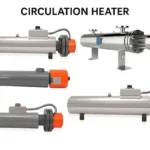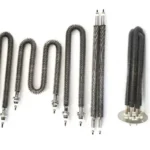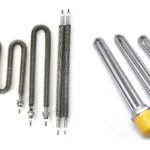Have you ever needed heat in a tight spot or on a curved surface? Flexible heating elements might be the answer. But what exactly are they and how do you choose the right one?
Flexible heating elements are thin, bendable heaters that can conform to various shapes. They provide efficient and targeted heat in diverse applications. Common types include silicone, polyimide, and PET heaters. They are used in industries like aerospace, medical, and electronics.
Flexible heaters are a great choice for many heating needs. To help you understand them better, let’s explore some key aspects. We will look at their types, materials, applications, and selection criteria.
What is a Flexible Heating Element? Types, Materials, and Key Applications?
Imagine needing to heat a curved pipe or a small electronic device. Standard heaters just won’t work. This is where flexible heating elements shine.
Flexible heating elements are heaters designed to bend and fit irregular surfaces. They typically consist of a heating circuit laminated between thin, flexible materials. Common types include silicone, polyimide (Kapton), and polyester (PET) heaters. They are used in medical devices, aerospace equipment, and consumer electronics.
Flexible Heater Types and Materials
Different applications need different types of flexible heaters. I have made a table to help you understand better.
| Heater Type | Material | Temperature Range | Key Features | Typical Applications |
|---|---|---|---|---|
| Silicone | Silicone Rubber | -60°C to 230°C (-76°F to 446°F) | Excellent flexibility, moisture resistance, good chemical resistance | Food warming, battery heating, freeze protection |
| Polyimide | Kapton | -200°C to 260°C (-328°F to 500°F) | High-temperature resistance, thin profile, excellent dielectric strength | Aerospace, satellites, medical devices, semiconductor equipment |
| PET | Polyester | -40°C to 100°C (-40°F to 212°F) | Low cost, good tensile strength | Consumer electronics, low-temperature applications |
| Etched Foil | Various Metals | Depends on metal, up to 600°C (1112°F) for some alloys | Precise heat distribution, complex shapes possible | High-performance applications, aerospace, defense |
| Wire Wound | Various Alloys | Depends on wire, up to 1000°C (1832°F) for some alloys | High watt density, robust construction | Industrial heating, process heating |
As you can see, silicone heaters are great for general use because they are flexible and resist moisture. Polyimide heaters are better for high-temperature uses. PET heaters are good for low-cost applications. Etched foil heaters allow precise heat and wire wound heaters are more robust. The choice of material depends on the specific needs of the application. Understanding these differences can help you choose the right heater for your project.
Silicone vs. Polyimide Flexible Heaters: Which is Right for Your Project?
Choosing between silicone and polyimide flexible heaters can be tough. Both offer flexibility, but their properties differ significantly.
Silicone heaters excel in applications needing flexibility and moisture resistance, with a temperature range of -60°C to 230°C. Polyimide heaters are ideal for high-temperature environments, offering a wider range from -200°C to 260°C. Consider temperature, chemical exposure, and required lifespan to make the best choice.
Key Differences and Considerations
To make the right choice, think about these points.
| Feature | Silicone Heaters | Polyimide Heaters |
|---|---|---|
| Temperature Range | -60°C to 230°C (-76°F to 446°F) | -200°C to 260°C (-328°F to 500°F) |
| Flexibility | Excellent | Good, but can be more rigid at lower temperatures |
| Chemical Resistance | Good resistance to many chemicals, but not all | Excellent resistance to most chemicals |
| Moisture Resistance | Excellent | Good |
| Cost | Generally lower | Generally higher |
| Typical Lifespan | Moderate to long | Long |
| Applications | Food equipment, battery warmers, freeze protection | Aerospace, medical devices, electronics, semiconductor |
Silicone heaters are a good choice if you need a flexible heater that can handle moisture. They are often used in food equipment and to keep batteries warm. Polyimide heaters are better for high-temperature uses and harsh chemicals. For example, they are common in aerospace and medical devices where reliability is key. I remember one time we had a customer who needed a heater for a satellite. Polyimide was the obvious choice because of its ability to withstand extreme temperatures in space.
Top 5 Industrial Uses for Ultra-Thin Flexible Heaters (and How They Work)
Ultra-thin flexible heaters are changing many industries. Their ability to fit into tight spaces and provide precise heat makes them very useful.
Ultra-thin flexible heaters are used in industries like aerospace, electronics, and medical devices. They provide targeted heat for applications like satellite components, LCD screens, and medical diagnostics. Their thin profile and flexibility allow them to fit into small spaces and conform to complex shapes, improving efficiency and performance.
Common Applications and How They Work
Here are five key industrial uses:
| Industry | Application | How It Works |
|---|---|---|
| Aerospace | Satellite components, de-icing | Heaters prevent freezing and maintain optimal operating temperatures for sensitive electronics. |
| Electronics | LCD screens, 3D printers | Evenly distributes heat to improve display quality and maintain consistent printing temperatures. |
| Medical Devices | Diagnostic equipment, patient warming | Provides precise temperature control for accurate readings and patient comfort. |
| Food Processing | Food warming, temperature maintenance | Keeps food at safe temperatures during processing and transportation, preventing spoilage. |
| Automotive | Battery warming, sensor heating | Improves battery performance in cold weather and ensures accurate sensor readings. |
These heaters work by converting electrical energy into heat. The heating element, usually a thin metallic foil or wire, is sandwiched between flexible insulating layers. When electricity flows through the element, it heats up. The heat then transfers to the surrounding area. The thin profile and flexibility of these heaters allow them to be placed exactly where heat is needed. This increases efficiency and reduces energy waste.
How to Choose a Flexible Heater: Temperature, Adhesion, and Durability Factors?
Choosing the right flexible heater involves several important factors. Temperature requirements, adhesion, and durability are key considerations.
To choose a flexible heater, consider the operating temperature range, the type of adhesive needed for secure mounting, and the heater’s ability to withstand environmental conditions. Match the heater’s specifications to the demands of your application for optimal performance and longevity.
Key Factors to Consider
Let’s break down the key factors.
| Factor | Description | Considerations |
|---|---|---|
| Temperature | The maximum and minimum temperatures the heater will experience. | Choose a heater with a temperature range that exceeds your application’s needs. Consider any temperature spikes or fluctuations. |
| Adhesion | How well the heater sticks to the surface. | Select an adhesive that is compatible with the mounting surface and the operating temperature. Options include pressure-sensitive adhesives (PSA) and epoxy bonding. |
| Durability | The heater’s ability to withstand wear and tear, chemical exposure, and mechanical stress. | Consider the environmental conditions the heater will face. Choose materials that are resistant to chemicals, moisture, and abrasion. Look for heaters with reinforced construction for added durability. |
| Watt Density | The amount of power (watts) per unit area (e.g., watts per square inch). | Calculate the required wattage based on the size of the area to be heated and the desired temperature increase. Avoid excessive watt density, which can lead to overheating and premature failure. |
| Size and Shape | The physical dimensions and form factor of the heater. | Ensure the heater fits the available space and conforms to the shape of the surface to be heated. Custom shapes and sizes are often available for specialized applications. |
When selecting a flexible heater, it’s important to balance these factors. You need a heater that can handle the heat, stick securely, and last a long time.
Custom Flexible Heating Solutions: When to Consider Bespoke Designs?
Sometimes, standard flexible heaters just don’t cut it. That’s when you need a custom solution.
Consider custom flexible heating solutions when standard heaters don’t meet your specific needs. This includes unique shapes, precise temperature control, or specialized material requirements. Bespoke designs ensure optimal performance and efficiency in demanding applications.
Reasons to Go Custom
Here’s when custom designs are beneficial:
| Scenario | Explanation | Example |
|---|---|---|
| Unique Shape or Size | Standard heaters may not fit irregular surfaces or tight spaces. | Heating a curved pipe or a small electronic component. |
| Precise Temperature Control | You need very specific temperature uniformity or zoning. | Maintaining a consistent temperature across a large display or heating specific areas of a medical device. |
| Specialized Material Requirements | Standard materials can’t withstand the operating environment. | Using chemically resistant materials for a heater in a laboratory or high-temperature materials for aerospace applications. |
| Integrated Sensors or Controls | You need built-in temperature sensors, controllers, or other electronic components. | Creating a self-regulating heater with automatic shutoff or temperature monitoring. |
I recall a project where a client needed a heater for a complex piece of lab equipment. The standard heaters wouldn’t fit, and they needed very precise temperature control. We designed a custom heater with integrated sensors. The result was perfect and they got the precise heating they needed. Custom solutions cost more upfront, but they can save money in the long run by improving efficiency and reducing downtime.
Conclusion
Flexible heating elements offer versatile solutions for diverse heating needs. Understanding their types, materials, and key considerations ensures you choose the best option for your application.











